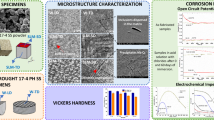Abstract
The 12% chromium type EN 1.4003 ferritic stainless steels are susceptible to grain growth and associated embrittlement in the heat-affected zone during welding. Grain growth can be restricted by increasing the amount of austenite that forms on cooling through the dual-phase (austenite+ferrite) field. This investigation examined ways of locally increasing the interstitial (carbon or nitrogen) content of the heat-affected zone during welding, and studying the effect of such an increase in interstitial content on the microstructure and mechanical properties of the welded joints. Significant changes in heat-affected zone microstructure and mechanical properties were observed on increasing the carbon content of the weld metal through the use of a higher-carbon welding consumable, and on increasing the weld metal nitrogen content through the use of nitrogen-containing shielding gas. This suggests that the weld thermal cycle is sufficiently long to allow diffusion from the weld metal across the fusion line into the high temperature heat-affected zone, resulting in higher levels of martensite, smaller ferrite grain sizes, higher heat-affected zone hardness values, and improved toughness.
Similar content being viewed by others
References
3CR12 — The Utility Stainless Steel, Technical Manual published by Columbus Stainless, 1997.
3CR12 — Technical Data, Technical Manual published by Columbus Stainless, 2004.
Maxwell D.K., Warrington J., Dewar K.: From niche to commodity, 3CR12 — a ten-year scenario, Corrosion Reviews, 1993, 11, 3–4, pp. 17–32.
Grobler C.: Weldability studies on 12% and 14% chromium steels, PhD dissertation, University of Pretoria, South Africa, 1987.
Meyer A.M.: Interstitial diffusion from the weld metal into the high temperature heat affected zone in 11–12 percent chromium steel welded joints, MEng thesis, University of Pretoria, South Africa, 2000.
Folkhard E.: Welding Metallurgy of Stainless Steels, Springer-Verlag, Vienna, 1988, p. 11.
Greeff M.L.: The influence of welding parameters on the sensitisation behaviour of 3CR12, MSc thesis, University of Pretoria, South Africa, 2005.
Gooch T.G., Ginn B.J.: Heat-affected zone toughness of MMA welded 12% Cr martensitic-ferritic steels. Report from the cooperative research programme for research members only, The Welding Institute, Cambridge, England, 1988, pp. 3–30.
Zaayman J.J.J.: The heat-affected zone toughness of welds in 11 to 12 per cent chromium steels, MEng thesis, University of Pretoria, South Africa, 1992.
Hawkins D.N., Beech J., Valtierra-Gallardo S.: A new approach to microstructural control in duplex stainless steel welds, Sheffield, 1988, pp. 199–203.
Rosenthal D.:The theory of moving sources of heat and its application to metal treatments, Transactions of the AIME 68, 1946, pp. 849–866.
Author information
Authors and Affiliations
Rights and permissions
About this article
Cite this article
Meyer, A.M., Du Toit, M. The Influence of Interstitial Diffusion Across the Fusion Line on the HAZ Microstructure and Properties in 12% Chromium Type 1.4003 Steels. Weld World 52, 42–49 (2008). https://doi.org/10.1007/BF03266681
Published:
Issue Date:
DOI: https://doi.org/10.1007/BF03266681




